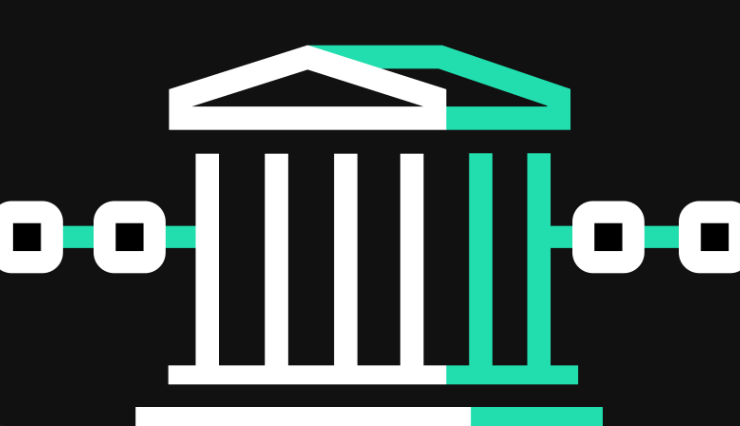
How is blockchain changing the current banking landscape?
The banking industry manages and coordinates the financial system through its internal accounting systems, acting as an intermediary in the global economy. Since such accounting data is not publicly disclosed, the public is forced to trust the banking system and its outdated infrastructure.
Blockchain technology has the potential to disrupt global currency markets and even reshape the entire banking industry by eliminating intermediaries, enabling the creation of easily accessible, borderless, and transparent systems that can replace traditional banking—all without the need for trust.
Blockchain offers advantages such as faster and lower-cost transactions, controlled access to capital, enhanced data security, and the execution of trustless agreements through smart contracts, making compliance smoother.
Moreover, given blockchain’s innovative nature, the way new financial components interact could give rise to entirely new types of financial services.
What Are the Key Advantages of Blockchain in Banking and Finance?
-
Security: Blockchain-based architecture eliminates single points of failure and removes the need to entrust data to intermediaries.
-
Transparency: Blockchain standardizes shared processes and creates a single source of truth for all network participants.
-
Trust: A fully transparent ledger makes collaboration between parties easier.
-
Programmability: Blockchain can automate business processes by creating and executing smart contracts.
-
Privacy: Blockchain’s privacy features allow selective data sharing between enterprises.
-
High Performance: Blockchain networks are designed to handle high transaction volumes while supporting interoperability between different chains, creating interconnected networks.
Fast Settlement Using Blockchain Technology
Transferring money in the current banking system can be a lengthy process, incurring various fees for banks and customers, and requiring cumbersome verification and management. In the era of interconnectedness, traditional banking systems can no longer keep up with technological advancements.
Blockchain technology offers a more convenient payment method with lower fees, available 24/7, borderless, and with the same security guarantees as traditional systems.
Fundraising Through Blockchain
Traditionally, entrepreneurs seeking funding would turn to external financiers such as angel investors, venture capitalists, or bankers. This can be a complex and stringent process involving lengthy negotiations over valuations, equity splits, and corporate strategies.
Initial Coin Offerings (ICOs) and Initial Exchange Offerings (IEOs) provide emerging projects with opportunities to raise capital without banks or financial institutions. With blockchain, companies can sell tokens in exchange for funding, offering returns to investors. In the traditional model, banks charge hefty fees to facilitate securitization and Initial Public Offerings (IPOs), but blockchain eliminates these costs.
It’s worth noting that while ICOs democratize fundraising, they also pose risks. Launching an ICO is relatively easy, allowing projects to raise significant funds without formal contracts guaranteeing their promises. The ICO market remains largely unregulated, exposing investors to substantial financial risks.
Asset Tokenization on Blockchain
Buying and selling securities and other assets (e.g., stocks, bonds, commodities, currencies, and derivatives) requires complex coordination between bank brokers, clearinghouses, and stock exchanges. The process must be efficient and accurate, but as complexity increases, so do time and costs.
Blockchain simplifies this by providing a foundational layer that enables easy tokenization of all asset types. Most financial assets are already traded digitally, making blockchain-based tokenization a convenient solution for all participants.
Currently, some blockchain innovators are exploring how to tokenize real-world assets like real estate, art, and commodities. This allows the transfer of valuable assets in a low-cost, more efficient manner. It also opens new investment opportunities, enabling investors to access previously inaccessible high-value assets.
Lending via Blockchain Technology
Banks and lending institutions have monopolized the loan business, typically offering loans at high interest rates and restricting access based on credit scores. This makes borrowing slow and expensive. Banks naturally dominate lending for high-cost items like cars and property.
Blockchain allows anyone worldwide to participate in a new lending ecosystem, part of decentralized finance (DeFi). DeFi aims to place all financial applications on the blockchain to create a more accessible financial system.
Peer-to-peer lending via blockchain enables unlimited borrowing in a fast, secure, and low-cost manner. The competitive lending environment fostered by blockchain will force banks to offer better loan terms to customers.
Blockchain’s Impact on Global Trade Finance
International trade imposes numerous rules and regulations on importers and exporters, making cross-border transactions cumbersome. They must track goods at every stage and manually handle processes involving extensive paperwork and ledgers.
Blockchain provides trade finance participants with greater transparency through a shared ledger that accurately tracks goods globally. By streamlining trade finance, blockchain saves time and money for importers, exporters, and businesses.
More Secure Contract Agreements via Smart Contracts
Businesses and individuals rely on contracts for protection, but this is costly. Due to their complexity, contracts often require extensive work from legal experts.
Smart contracts automate agreements using blockchain’s tamper-proof, deterministic code. Funds can be securely held in escrow and released only when conditions are met.
Smart contracts reduce the need for trust, minimizing financial risks and disputes.
Data Integrity and Security via Blockchain
Centralized institutions risk data breaches when sharing information. Many financial institutions still use paper-based storage, increasing record-keeping costs.
Blockchain simplifies processes like automated data validation and reporting, digital KYC/AML, transaction history recording, and real-time authentication of financial documents. This reduces operational and fraud risks while cutting data processing costs for financial institutions.
Conclusion
Banking and finance are among the industries most impacted by blockchain technology. Potential use cases range from real-time transactions to asset tokenization, lending, smoother international trade, and stronger digital contracts.
Overcoming technical and regulatory hurdles is only a matter of time before blockchain enables a new financial infrastructure.
Trustless, transparent, and borderless banking and finance will play a crucial role in building a more open and interconnected global economy.
















